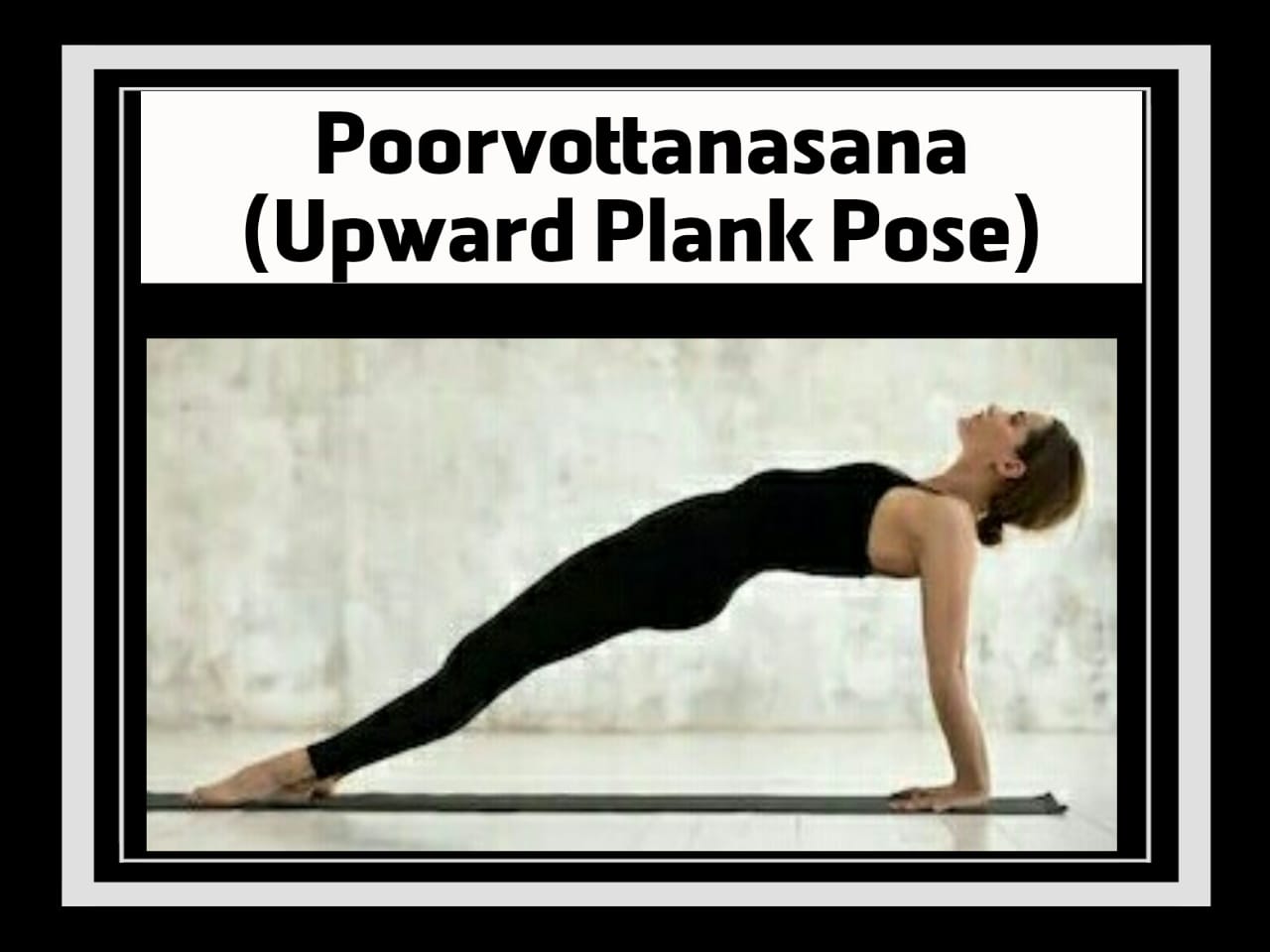Poorvottansana (Upward Plank Pose)
In this asana, the entire body weight is on the palms. This asana gives tension to the muscles and nerves of the entire body. Poorvottanasana has been composed of two words – Purva and Uttan. In simple words, Poorvottanasana means pulling the body in the east direction.
However, you can do this asana in any direction, it has no relation to the east direction. Doing Poorvottanasana energizes the body and provides relief from stress.

If you do it in a steady and balanced manner, it can improve physical strength and mental strength. Practicing it regularly helps in improving physical and mental health and makes a person healthy and strong.
How to Do Poorvottasana (Upward Plank Pose)
♦ To do Poorvottanasana, sit in Dandasana with both legs straight in front of you.
♦ Now place both your hands behind the hips at a short distance (about one foot).
♦ Place your palms on the floor and ensure that the fingers of both hands remain in the direction of the feet.
♦ Inhale, raise the pelvic area, keep the body straight.
♦ Keep the knees straight, keep the feet on the ground, keep the toes on the ground, by doing this the sole will remain on the ground. Let the head go back towards the ground.
♦ Shoulders and legs will be in a straight line.
♦ Now raise your hips so that your chest rises.
♦ Now tilt the head backwards.
♦ Remain in this position as per your convenience and then come back to your starting position.
♦ Keep breathing in this position.
♦ Exhale and come back, sit down, relax.
♦ Note that you should breathe correctly and work according to the limits of your body while doing this asana.
Benefits of Poorvottanasana (Upward Plank Pose)
Strengthening the muscles: Practicing this asana strengthens the muscles of your legs, arms, shoulders, and stomach.
Reducing belly fat: This asana helps in reducing belly fat.
Improves the digestive system: Poorvottanasana helps in improving the digestive system. And helps in providing relief from constipation.
Strengthening the waist: This asana strengthens the waist muscles and helps in reducing back pain.
Mental peace: This asana helps in mental peace and meditation and is helpful in reducing stress.
Improvement in function of thymus gland:
The thymus gland is located behind the chest in front of the trachea. This gland helps in maintaining the immune system. While doing Purvottanasana, the chest is raised upwards, due to which this gland gets a lot of benefits.
Improves balancing:
Poorvotanasana is very helpful in improving balance. If you do these simple exercises regularly, your balance improves and the mental and physical capacity of the body also increases.
The bones, muscles, nerves etc. of the entire body get massaged. The body becomes flexible and radiant. Other benefits of Poorvottanasana are as follows –
1. The mind remains calm and stable.
2. Working capacity increases.
3. Brain power increases.
4. Throat disorders are cured.
5. Makes the lungs expanded and successful, which increases the working capacity of the heart.
6. The chest, back, waist, shoulders and arms become well-built and powerful.
Precautions
Follow the following precautions while doing Poorvottanasana:
♦ If you have any health problems related to the practice of Poorvottanasana, consult a doctor and work as per his guidance.
♦ If you have injury or pain in your waist, buttocks, or shoulders, do not do this asana.
♦ If you have neck problem, pain or swelling in the neck, then do not do Poorvotanasana at all.
♦ There is no need to do this asana again and again, especially if you are new. Start slowly and increase depending on your condition.
♦ While doing the asana, exhale carefully and follow the values of yoga.
♦ Do not do this asana for any kind of injury and if any pain or unwellness occurs, immediately consult a doctor.
What is poorvottanasana in English?
“Poorvottanasana” is known as “Upward Plank Pose” in English. It is a yoga asana that involves lifting the body off the ground while supporting it on the hands and feet, with the torso facing upwards.
Frequently Asked Questions
What mucels does poorvottanasana work?
Poorvottanasana affects various muscles, such as the muscles of the hands, the muscles of the back of the shoulders, the muscles of the abdominal hairs, and the muscles of the legs. This asana mainly helps in strengthening the muscles of the arms, shoulders, abdomen and legs.
What is the duration of poorvottanasana?
This asana can be done for a duration ranging from 15 seconds to 1 minute. If you are new or have no body practice, it is good to start slowly and build up over time. Initially one can start doing the asana for 15-30 seconds and then gradually increase the duration.
What are the benefits of poorvottanasana?
Strengthens the wrists, arms, shoulders, back and spine. Legs and hips get exercise. Improves breathing process. Creates stretch in the intestines and abdominal organs. Stimulates the thyroid gland.
Who should not do poorvottanasana?
Poorvottanasana should not be done by people who have back problems, during pregnancy, and if one has heart related problems.
Read Also
- Makarasana (Crocodile Pose): How to Do Makarasana & Benefits
- Shalbhasana (Locust Pose)- Benefits & Steps
- Setu Bandhasana (Bridge Pose)- Benefits & Steps
- Mandukasana (Frog Pose)-Steps And Benefits
- Ustrasana (Camel Pose)- Benefits, Steps & Precautions